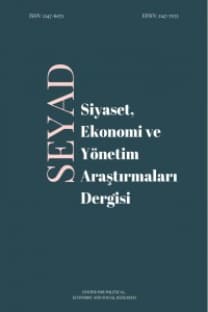Türkiye’de Ekonomik Gelişme ve Kadınların İşgücüne Katılım Oranı: U-Eğrisi Hipotezinin Testi
Ekonomik Gelişme, Kadın İşgücüne Katılım Oranı, U-Eğrisi Hipotezi, ARDL
Economic Development And The Women Labor Force Participation Rate In Turkey: Test of U-Curve Hypothesis
___
- Çağatay, Nilüfer and Şule Özler (1995), “Feminization of The Labor Force: The Effects Of Long- Term Development And Structural Adjustment” World Development, Volume: 23, Issue:11, p.1883-1894.
- Fatima, Ambreen and Humera Sultana (2009), “Tracing Out The U-Shape Relationship Between Female Pakistan”, International Journal of Social Economics, Volume: 36, Issue:1/2, p.182-198. Participation Rate and Economic Development for
- Goldin, Claudia (1994), “The U-Shaped Female Labor Force Function in Economic Development and Economic History”, National Bureau of Economic Research, Working Paper No: 4707, p.1-40.
- Lahoti, Rahul and Hema Swaminathan (2013), “Economic Growth and Female Labour Force Participation In India”, IIM Bangalore, Working Paper No: 414.
- Luci, Angela (2009), “Female Labour Market Participation and Economic Growth” International Journal of Innovation and Sustainable Development, Volume: 4, Issue: 2-3, p.97-108.
- Mammen, Kristin and Christina Paxson (2000), “Women's Work and Economic Development”, The Journal of Economic Perspectives, Volume: 14, Issue:4, p.141-164.
- Pesaran, M. Hashem, Yongcheol Shin, and Richard J. Smith. (2001), “Bounds Testing Approaches to the Analysis of Level Relationships.”, Journal of Applied Econometrics, Volume: 16, Issue:3, p.289–326.
- Tam, Henry (2011), “U-Shaped Female Labor Participation with Economic Development: Some Panel Data Evidence”, Economics Letters, Volume: 110, Issue:2, p.140-142.
- Tansel, Aysit (2001), “Economic Development and Female Labor Force Participation in Turkey: Time-Series Evidence and Cross-Province Estimates” Economic Research Forum for the Arab Countries, The World http://data.worldbank.org/indicator/EG.USE.ELEC.KH.PC, 14.01.2017. (Electric Power Consumption (kWh Per Capita)), TUİK, (Kişi Başına Düşen Gayri Safi Yurt İçi Hasıla), https://biruni.tuik.gov.tr/medas/?kn=88&locale=tr, 14.01.2017.
- TUİK, (İşgücüne Katılım oranı) https://biruni.tuik.gov.tr/isgucuapp/isgucu.zul, 14.01.2017.
- Yamak, Rahmi ve Havvanur Feyza Erdem (2016), “Armey Eğrisi: Türkiye Örneği” XVII. Uluslararasi Ekonometri, Yöneylem Araştirmasi Ve İstatistik Sempozyumu Tam Metin Kitabı, 2-4 Haziran, Sivas, s.250-261.
- ISSN: 2147-6071
- Yayın Aralığı: Yılda 2 Sayı
- Başlangıç: 2014
- Yayıncı: Politik Ekonomik ve Sosyal Araştırmalar Merkezi
G7 Ülkelerinde CO2 Emisyonu, Elektrik Tüketimi ve Büyüme İlişkisi
Suzan ERGÜN, Melike Atay POLAT
Kendinden Uyarımlı Eşik Otoregresif Modellerin Belirlenmesi İçin Genetik Algoritma Yaklaşımı
Kurumsal Kaynak Planlama Sistemlerinde Yapay Sinir Ağlarının Değerlendirilmesi Yaklaşımı
Girişimcilik ve Ekonomik Büyüme İlişkisi: Türkiye Örneği
Hüseyin AĞIR, Mehmet Akif KARA
Bengü Doğangün YASA, Mehmet Emin YARDIMCI
Savunma Harcamaları Düzeyinin Belirlenmesi: Teorik Bir Tartışma
Finansal Gelişme, Finansal Yapı ve Gelir Eşitsizliği
Nurullah ALTINTAŞ, Mustafa ÇALIŞIR
Türkiye’de Ekonomik Gelişme ve Kadınların İşgücüne Katılım Oranı: U-Eğrisi Hipotezinin Testi
Burçin ESER, Nebiye YAMAK, Serkan SAMUT
Soğuk Savaş’tan Bir Kesit: Yapısal Değişiklikler ve Bloklar Arası İlişkiler 1960-1991
